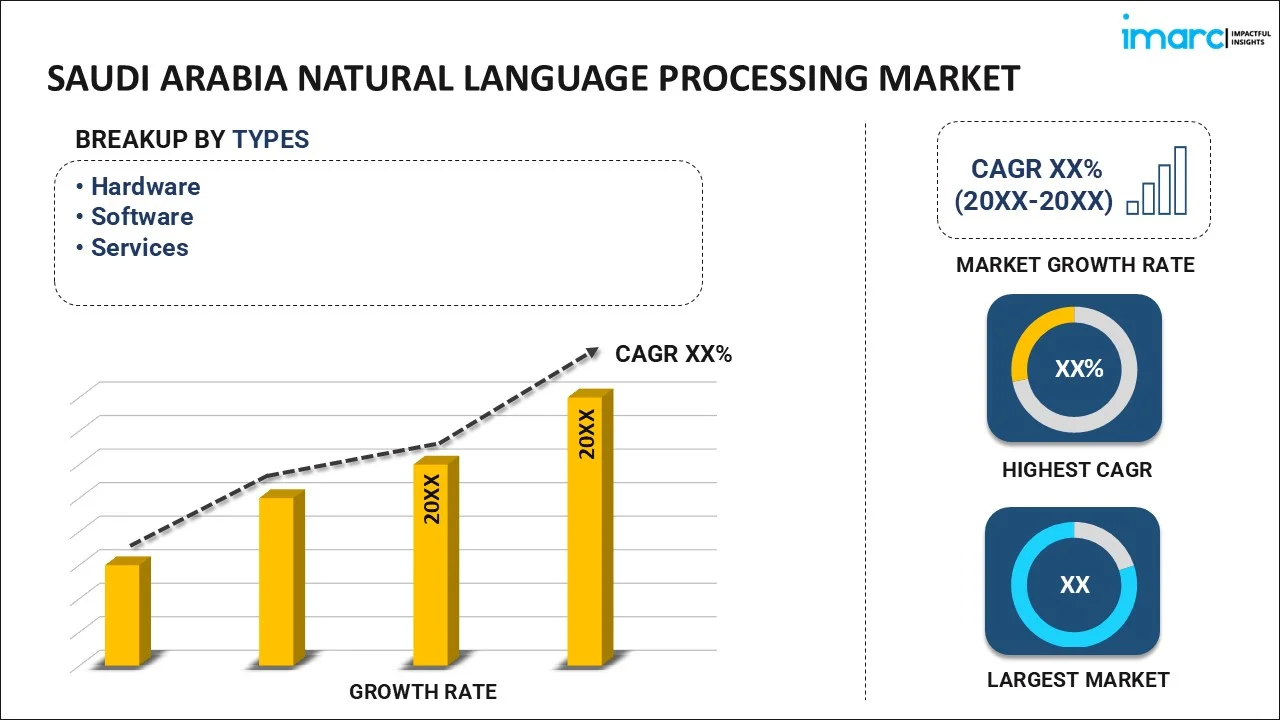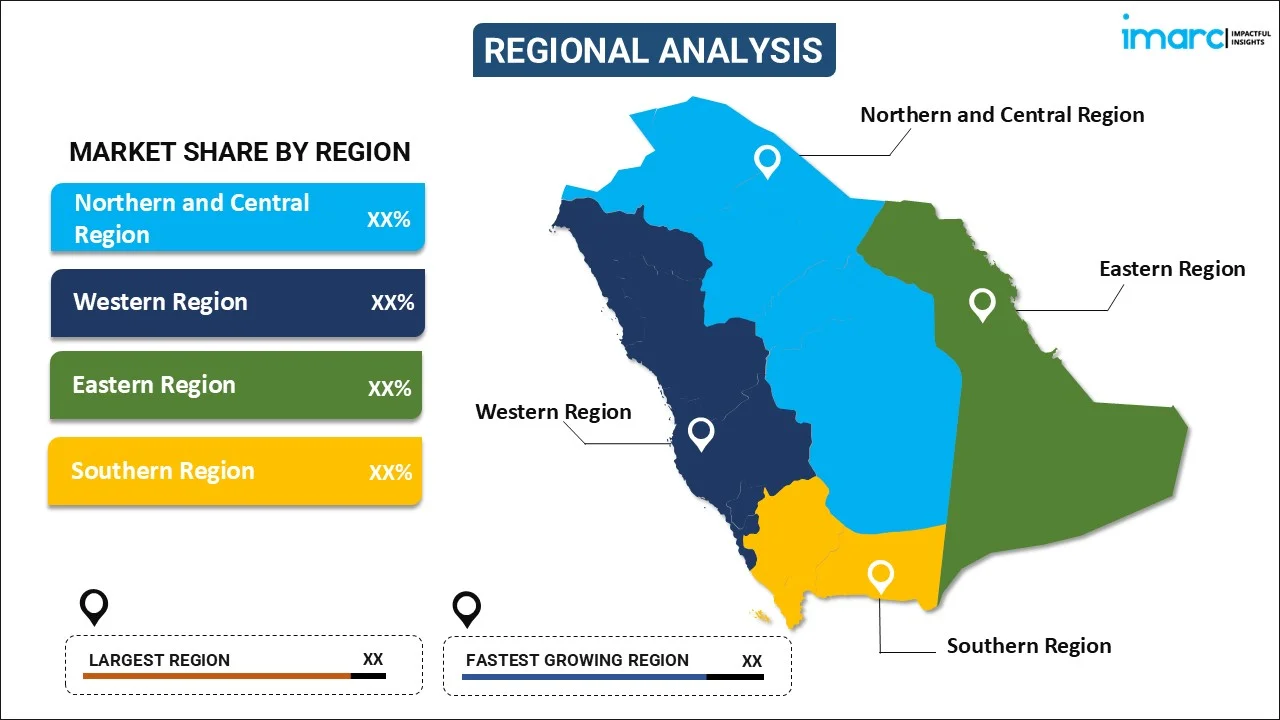
Saudi Arabia Natural Language Processing Market Size, Share, Trends and Forecast by Type, Technology, Deployment Mode, Organization Size, End User, and Region, 2025-2033
Saudi Arabia Natural Language Processing Market Overview:
The Saudi Arabia natural language processing market size reached USD 4.67 Billion in 2024. Looking forward, IMARC Group expects the market to reach USD 27.44 Billion by 2033, exhibiting a growth rate (CAGR) of 21.76% during 2025-2033. Government AI initiatives, Arabic language AI development, fintech expansion, chatbot adoption, healthcare digitization, rising cloud computing, e-commerce growth, smart city projects, demand for voice assistants, and enterprise automation are driving the growth of the Saudi Arabia natural language processing market.
|
Report Attribute
|
Key Statistics
|
|---|---|
|
Base Year
|
2024
|
|
Forecast Years
|
2025-2033
|
|
Historical Years
|
2019-2024
|
| Market Size in 2024 | USD 4.67 Billion |
| Market Forecast in 2033 | USD 27.44 Billion |
| Market Growth Rate (2025-2033) | 21.76% |
Saudi Arabia Natural Language Processing Market Trends:
Investments in AI Infrastructure
Saudi Arabia is realizing the critical role artificial intelligence plays in contemporary technology ecosystems and is investing heavily to strengthen its AI infrastructure. To improve computing capabilities for AI applications, such as natural language processing, U.S. semiconductor firm Groq obtained a $1.5 billion commitment from Saudi Arabia in February 2025 to provide the kingdom with cutting-edge AI chips. Salesforce also revealed that it has invested $500 million in Saudi Arabia, with an emphasis on AI research and the launch of its Hyperforce platform architecture in partnership with Amazon Web Services. Saudi Arabia's AI industry is projected to grow at a compound annual growth rate (CAGR) of 27.90% from 2025 to 2030. These investments are part of a broader strategy to position the kingdom as a global leader in AI. Moreover, the government's Vision 2030 initiative underscores AI as a key driver of economic diversification, fostering innovation across industries such as healthcare, finance, and smart cities. Collaborations with global tech leaders and academic institutions are further accelerating AI adoption, ensuring the development of a robust talent pool and cutting-edge research facilities. Moreover, regulatory frameworks are being refined to support AI governance and ethical deployment, reinforcing Saudi Arabia’s ambition to lead the region in AI advancements. With continued investments, the nation is poised to become a major player in the global AI landscape.
Enhancement of Arabic Language Processing
Saudi Arabia has started projects to improve Arabic language processing in order to address the language's underrepresentation in AI technology. The Artificial Intelligence Center for Arabic Language Processing was founded in Riyadh by the King Salman Global Academy for Arabic Language with the goal of creating AI-powered language innovations. To improve machine interactions with the Arabic language, this facility includes specialized labs for AI research, data processing, and virtual reality applications. The National Strategy for Data and Artificial Intelligence, which aims to establish the Kingdom as a worldwide leader in data and AI by 2030, is in line with these initiatives. Additionally, Saudi Arabia is fostering collaborations with international AI research institutions and technology firms to accelerate Arabic language AI development. These initiatives utilize deep learning, NLP, and large language models to enhance Arabic speech recognition, sentiment analysis, and machine translation. The government is also supporting AI-driven content creation and digital assistants tailored for Arabic-speaking users, ensuring greater linguistic inclusivity in the digital space. As AI adoption grows, these advancements will play a crucial role in bridging the gap between Arabic and other widely supported languages in global AI ecosystems.
Saudi Arabia Natural Language Processing Market Segmentation:
IMARC Group provides an analysis of the key trends in each segment of the market, along with forecasts at the region/country level for 2025-2033. Our report has categorized the market based on type, technology, deployment mode, organization size, end user, and region.
Type Insights:

- Hardware
- Software
- Services
The report has provided a detailed breakup and analysis of the market based on the type. This includes hardware, software, and services.
Technology Insights:
- Interactive Voice Response
- Optical Character Recognition
- Text Analytics
- Speech Analytics
- Classification and Categorization
- Pattern and Image Recognition
- Others
A detailed breakup and analysis of the market based on the technology have also been provided in the report. This includes interactive voice response, optical character recognition, text analytics, speech analytics, classification and categorization, pattern and image recognition, and others.
Deployment Mode Insights:
- On-premises
- Cloud-based
The report has provided a detailed breakup and analysis of the market based on the deployment mode. This includes on-premises and cloud-based.
Organization Size Insights:
- Large Enterprises
- Small and Medium-sized Enterprises
A detailed breakup and analysis of the market based on the organization size have also been provided in the report. This includes large enterprises, and small and medium-sized enterprises.
End User Insights:
- Education
- BFSI
- Healthcare
- IT and Telecom
- Manufacturing and Retail
- Media and Entertainment
- Others
A detailed breakup and analysis of the market based on the end user have also been provided in the report. This includes education, BFSI, healthcare, IT and telecom, manufacturing and retail, media and entertainment, and others.
Regional Insights:

- Northern and Central Region
- Western Region
- Eastern Region
- Southern Region
The report has also provided a comprehensive analysis of all the major regional markets, which include the Northern and Central Region, Western Region, Eastern Region, and Southern Region.
Competitive Landscape:
The market research report has also provided a comprehensive analysis of the competitive landscape. Competitive analysis such as market structure, key player positioning, top winning strategies, competitive dashboard, and company evaluation quadrant has been covered in the report. Also, detailed profiles of all major companies have been provided.
Saudi Arabia Natural Language Processing Market News:
- November 2024: Saudi Arabia established Project Transcendence, a $100 billion plan aimed at becoming a worldwide AI powerhouse, with a concentration on natural language processing. The program comprises creating Arabic-language AI models to address the underrepresentation of Arabic in AI frameworks. In accordance with its Vision 2030 goal, the nation is spending $10 billion on AI-related initiatives such as localized apps and Arabic NLP improvements.
- April 2024: The King Salman Global Academy for Arabic Language (KSGAAL) opened its first Arabic AI Centre for Natural Language Processing in Riyadh. The center's goal is to simplify AI technology adoption and enhance Arabic language leadership. It will offer integrated services such as AI-powered technical consults, seminars, and training sessions.
Saudi Arabia Natural Language Processing Market Report Coverage:
| Report Features | Details |
|---|---|
| Base Year of the Analysis | 2024 |
| Historical Period | 2019-2024 |
| Forecast Period | 2025-2033 |
| Units | Billion USD |
| Scope of the Report | Exploration of Historical Trends and Market Outlook, Industry Catalysts and Challenges, Segment-Wise Historical and Future Market Assessment:
|
| Types Covered | Hardware, Software, Services |
| Technologies Covered | Interactive Voice Response, Optical Character Recognition, Text Analytics, Speech Analytics, Classification and Categorization, Pattern and Image Recognition, Others |
| Deployment Modes Covered | On-premises, Cloud-based |
| Organization Sizes Covered | Large Enterprises, Small and Medium-sized Enterprises |
| End Users Covered | Education, BFSI, Healthcare, IT and Telecom, Manufacturing and Retail, Media and Entertainment, Others |
| Regions Covered | Northern and Central Region, Western Region, Eastern Region, Southern Region |
| Customization Scope | 10% Free Customization |
| Post-Sale Analyst Support | 10-12 Weeks |
| Delivery Format | PDF and Excel through Email (We can also provide the editable version of the report in PPT/Word format on special request) |
Key Questions Answered in This Report:
- How has the Saudi Arabia natural language processing market performed so far and how will it perform in the coming years?
- What is the breakup of the Saudi Arabia natural language processing market on the basis of type?
- What is the breakup of the Saudi Arabia natural language processing market on the basis of technology?
- What is the breakup of the Saudi Arabia natural language processing market on the basis of deployment mode?
- What is the breakup of the Saudi Arabia natural language processing market on the basis of organization size?
- What is the breakup of the Saudi Arabia natural language processing market on the basis of end user?
- What are the various stages in the value chain of the Saudi Arabia natural language processing market?
- What are the key driving factors and challenges in the Saudi Arabia natural language processing market?
- What is the structure of Saudi Arabia natural language processing market and who are the key players?
- What is the degree of competition in the Saudi Arabia natural language processing market?
Key Benefits for Stakeholders:
- IMARC’s industry report offers a comprehensive quantitative analysis of various market segments, historical and current market trends, market forecasts, and dynamics of the Saudi Arabia natural language processing market from 2019-2033.
- The research report provides the latest information on the market drivers, challenges, and opportunities in the Saudi Arabia natural language processing market.
- Porter's five forces analysis assist stakeholders in assessing the impact of new entrants, competitive rivalry, supplier power, buyer power, and the threat of substitution. It helps stakeholders to analyze the level of competition within the Saudi Arabia natural language processing industry and its attractiveness.
- Competitive landscape allows stakeholders to understand their competitive environment and provides an insight into the current positions of key players in the market.
Need more help?
- Speak to our experienced analysts for insights on the current market scenarios.
- Include additional segments and countries to customize the report as per your requirement.
- Gain an unparalleled competitive advantage in your domain by understanding how to utilize the report and positively impacting your operations and revenue.
- For further assistance, please connect with our analysts.
 Request Customization
Request Customization
 Speak to an Analyst
Speak to an Analyst
 Request Brochure
Request Brochure
 Inquire Before Buying
Inquire Before Buying




.webp)




.webp)












